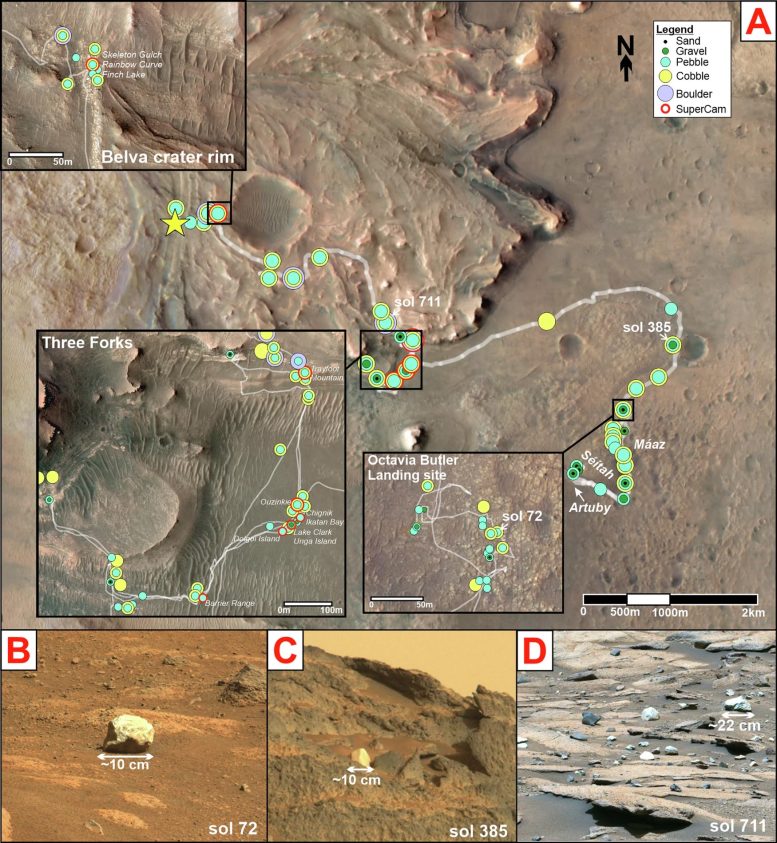
Pale rocks on the red planet reveal a watery past and suggest the potential for life.
Sometimes, scientists have to dig, work, and sweat to make scientific discoveries. And sometimes, a robot rolls over a rock that turns out to be a revelation.
That’s what happened when Mars exploration expert Roger Wiens, professor of Earth, Atmospheric, and Planetary Sciences in the College of Science at Purdue University, had NASA’s Perseverance rover fire its laser at some unusually pale rocks on the Martian surface — and discovered that they were composed of unusually high levels of aluminum associated with the mineral kaolinite.
That was interesting in itself, but what made the discovery truly fascinating is that this mineral typically forms only in very warm and wet environments. The finding, published by Wiens and his team in Nature Communications Earth & Environment, suggests that Mars may have been warmer, wetter, and weirder than scientists previously thought.

“On Earth, these minerals form where there is intense rainfall and a warm climate or in hydrothermal systems such as hot springs. Both environments are ideal conditions for life as we know it,” Wiens said. “These minerals are what’s left behind when rock has been in flowing water for eons. Over time, the warm water leaches away all the elements except those that are really insoluble, leaving behind what we found on Mars. It’s fascinating. It’s unexpected on a cold, dry planet like Mars.”
Rock hound rover
Wiens has worked on and with Mars rovers for decades and literally gave Perseverance its head. The blocky projection on top of the rover, which superficially resembles a quadruped’s neck and head, is SuperCam, an instrument developed by an international team of researchers and engineers that Wiens led before coming to Purdue. SuperCam is the result of a collaboration with Los Alamos National Laboratory and the French Institut de Recherche en Astrophysique et Planétologie, and is funded by NASA and the Centre National d’Études Spatiales in France.
The instrument uses a suite of techniques to analyze the Martian surface. Now Wiens leads the research team that uses SuperCam’s tools to make discoveries on Mars.
Researchers observed the small, pale pebbles in the Martian soil the first day the rover landed. But the rover team was too busy working on other things to check out the odd little rocks.
Eventually, scientists observed some larger rocks of a similar color lying on the surface, not part of the bedrock beneath the rover’s wheels. Geologists call these loose rocks “float rocks” because they are “floating” above the bedrock — they are out of place, away from where they were formed. Once SuperCam’s laser analyzed the rocks, the team members realized they had an interesting discovery.
“These rocks are very different from anything we’ve seen on Mars before,” Wiens said. “They’re enigmas.”

The team proceeded to analyze the rocks more deeply for insights into their composition and structure. Two researchers from Wiens’ team led the study. Candice Bedford, research scientist, and Clement Royer, postdoctoral researcher, had just arrived at Purdue when the discovery was made, and they developed the detailed study, along with Briony Horgan, professor of planetary science in the College of Science, and several of her and Wiens’ students. The team found more than 4,000 of these white rocks and pebbles scattered across the surface.
The mineral that makes up many of these pale rocks is called kaolinite. What especially excites the scientists is that it typically forms in environments that are warm, wet, and hospitable to some forms of microbial life. On Earth, it is found in sedimentary deposits resulting from ancient soils and coastlines and intense hydrothermal environments, and the mineral is quite soft. On Mars, the rocks are white but not as soft, possibly due to other processes that may have hardened the rocks.
These rocks were also found to contain spinel, likely aluminum spinel, which can form either in an igneous or a metamorphic environment, and can be found as remnants in sedimentary rocks. Wiens and his team are unsure which happened here — whether the spinel formed from the kaolinite or the kaolinite formed around the spinel.
Once upon a blue Mars
“The big questions about Mars are about water,” Wiens said. “How much water was there? How long was there water? Given how cold and dry Mars is now, where did all that water go? As a mineral, kaolinite has a lot of water bound up in its structure. It’s possible that a lot of the water is still there, on Mars, bound up in the minerals.”
“Although we have not seen these rocks ‘in place’ in bedrock with the rover, and we’re not sure where these float rocks came from, from orbiting satellites we know that there are kaolinite-rich rocks in Jezero crater’s rim,” said Bedford, co-lead author of this research. “Investigating these rocks in place will help us test our hypotheses on how the rocks formed, how they relate to Mars’ ancient environment, and the habitability of the planet in the past. We are keeping our eyes wide open looking for the source of these rocks now that Perseverance is exploring the crater rim.”
Those insights might help guide humans to the first true signs of ancient extraterrestrial life, since, as far as we can tell, life can’t exist without water. By studying Mars’ present, scientists uncover clues to its — and Earth’s — past, as well as insight into where to look for hints of life in the future.
Reference: “Intense alteration on early Mars revealed by high-aluminum rocks at Jezero crater” by C. Royer, C. C. Bedford, J. R. Johnson, B. H. N. Horgan, A. Broz, O. Forni, S. Connell, R. C. Wiens, L. Mandon, B. S. Kathir, E. M. Hausrath, A. Udry, J. M. Madariaga, E. Dehouck, R. B. Anderson, P. Beck, O. Beyssac, É. Clavé, S. M. Clegg, E. Cloutis, T. Fouchet, T. S. J. Gabriel, B. J. Garczynski, A. Klidaras, H. T. Manelski, L. Mayhew, J. Núñez, A. M. Ollila, S. Schröder, J. I. Simon, U. Wolf, K. M. Stack, A. Cousin and S. Maurice, 7 November 2024, Communications Earth & Environment.
DOI: 10.1038/s43247-024-01837-2
Never miss a breakthrough: Join the SciTechDaily newsletter.
6 Comments
Where on Mars? Obviously Eastern Hemisphere, right? Trying to match the topography with my Nat Geo Atlas of the World, 2016.
The maps above says “Belva crater” and that’s located at approximately 16.6° South latitude and 34.6° East longitude according to Google.
Given the frequency and regularity that scientists are stunned and shocked, it’s puzzling how many survive and why so many enter the field in the first place.
I’m still chuckling. Bravo!
I now have images of scientists running out of the building screaming and the building security guards thinking “This happens every week”.
I see no sane reason why the early millennia of Mars could not involve hydrothermal processes. A benign tropical climate could be an interesting kettle of fish.
Where on Mars ? I am trying to match the topography by looking at the map of it in my Nat Geo Atlas of the World. Eastern Hemisphere?